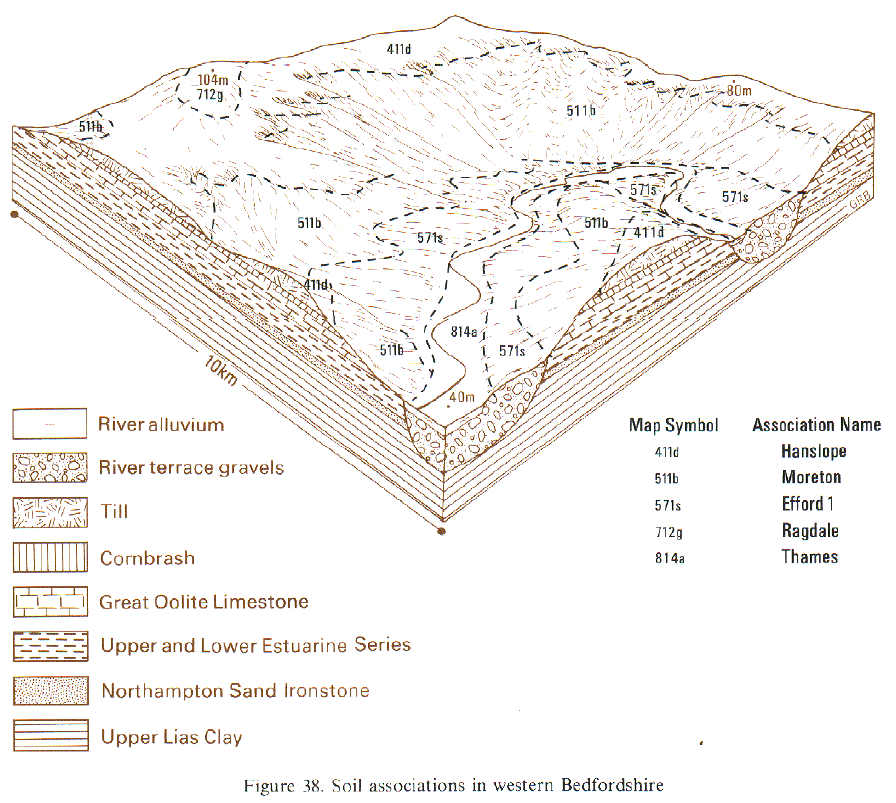
Soil Associations
0511b Moreton
Soil and site characteristics
Well drained calcareous clayey and fine loamy soils over limestone, in places shallow and brashy. Some deeper slowly permeable calcareous clayey soils.
Geology
Jurassic clay and limestone
Cropping and Land Use
Winter cereals; some short term grassland and potatoes.
Component soil series
| Subgroup | Series name | Percentage | WRB 2006 link |
|---|---|---|---|
| 5.11 | MORETON | 32% | Calcaric Endoleptic Cambisols |
| 4.11 | EVESHAM | 22% | Calcaric Stagnic Vertic Cambisols |
| 4.11 | HASELOR | 10% | Clayic Calcaric Endoskeletic Cambisols |
| 3.43 | SHERBORNE | 10% | Calcaric Leptosols |
| 3.43 | ELMTON | 10% | Calcaric Leptosols |
| 5.11 | ABERFORD | 10% | Calcaric Endoleptic Cambisols |
Covers 276 km2 in England and Wales
Soilscapes Classification
| 5 |
Freely draining lime-rich loamy soils |
0511b Moreton
Detailed Description
The Moreton association is complex and consists mainly of calcareous clayey soils over well-fissured Jurassic clay and limestone on gentle and moderately sloping valley sides in Northamptonshire, Bedfordshire, north Buckinghamshire and north Oxfordshire. The dominant Moreton soils, typical brown calcareous earths, are associated with similar but fine loamy Aberford soils. Typical calcareous pelosols of the Evesham and Haselor series and brown rendzinas of the Sherborne and Elmton series also occur. Moreton, Sherborne, Aberford and Elmton soils overlie limestone at shallow or moderate depth and are well drained and variably stony. Locally the soils show bedrock patterns). Evesham soils have slowly permeable subsoils, are seasonally waterlogged and are usually stoneless throughout but interbedded bands of limestone in Haselor soils give stony subsoils.
The association covers about 200 km² in Northamptonshire, Bedfordshire and Cambridgeshire where Jurassic limestone is interbedded with clay shales along the main river valleys. It flanks the river Nene between Northampton and Peterborough and the Great Ouse west of Bedford. However, because of the inconstancy of the limestone, the proportions of component soils vary. In some places, Haselor soils are dominant, in others Aberford series. Around Wellingborough and south of Northampton, Evesham and Sherborne soils are locally common but east of Thrapston, on limestone capping a small spur, Moreton and Sherborne soils predominate. Fine loamy Aberford and Elmton soils are scattered widely and between Wellingborough and Bedford they cover more than a fifth of the land. Locally, Oxpasture and Holdenby series are found in thin drift along the margins of the map separates and inclusions of Denchworth together with some prominently mottled Evesham soils occur in valley bottoms and where springs issue from the limestones.
In South East England the association is found in north Oxfordshire and north Buckinghamshire, where Jurassic limestones are interbedded with clay shales. It is best represented in the valley of the Great Ouse north of Newport Pagnell with a small patch west of Bicester. Because of the patchy distribution of the limestone, the proportions of component soils vary. The association also includes small areas of Holdenby soils in thin drift.
Soil Water Regime
Moreton, Aberford, Sherborne and Elmton soils are moderately to very porous in the topsoil and because of the shallow depth to shattered limestone are well drained (Wetness Class I). However, compaction from poorly-timed cultivations or intensive stocking can cause surface waterlogging unless alleviated by subsoiling. Evesham and Haselor soils are moderately porous in the topsoil but downward water movement is restricted by slowly permeable subsoils and they are seasonally waterlogged (Wetness Class III). Sherborne and Elmton soils are moderately or very droughty for all crops, but the slightly deeper Moreton, Aberford and Haselor soils are moderately droughty for cereals. The Evesham series is slightly droughty for cereal crops where annual rainfall is more than 600 mm, but, in drier districts, is moderately and very droughty for potatoes and grass respectively. In most years, yields are limited and in dry years some crops are severely affected by drought.
Cropping and Land Use
Autumn-sown cereals are the main crops. In the drier eastern districts some potatoes are grown, though stones hamper harvesting. There is some permanent grassland on the steeper valley sides and near springs. In lower rainfall areas, for example at Bedford (550 mm), all the soils have a long period suitable for landwork in autumn and, except in wet years, there is also a useful period in spring. In wetter districts, for example at Silverstone with 700 mm of rainfall, the autumn period is much shorter and only Sherborne and Elmton soils have an adequate landwork period in an average spring. The marked soil variation that is commonly found within a field, from seasonally waterlogged clayey soils to well drained stony soils, often makes it difficult to time cultivations correctly and timing is often a compromise. The soils are not well suited to direct drilling because of stoniness and, in wet areas, because of smearing and the risk of slug damage to cereals. Droughtiness reduces summer growth of grass and restricts pasture use on the Moreton, Aberford, Sherborne and Elmton soils, but on the wetter Evesham and Haselor soils, which have large retained water capacities, poaching is the main restriction to grazing. The soils are calcareous with non-calcareous but nearly neutral topsoils. The soils inherently have a good phosphorus and poor potassium status but levels vary with past management.
0511b Moreton
Distribution Map
 |
Note that the yellow shading represents a buffer to highlight the location of very small areas of the association.
Keys to component soil series
Eastern Region
 |
Typical Landscapes
Eastern Region
 |
Eastern Region
 |
Eastern Region
 |
All information Copyright, Cranfield University © 2024
Citation: To use information from this web resource in your work, please cite this as follows:
Cranfield University 2024. The Soils Guide. Available: www.landis.org.uk. Cranfield University, UK. Last accessed 23/04/2024
